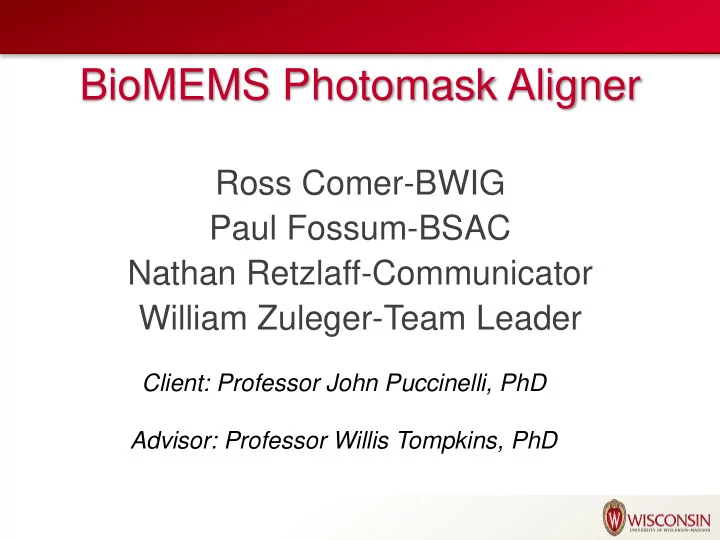

BioMEMS Photomask Aligner Ross Comer-BWIG Paul Fossum-BSAC Nathan Retzlaff-Communicator William Zuleger-Team Leader Client: Professor John Puccinelli, PhD Advisor: Professor Willis Tompkins, PhD
Overview • BioMEMS • Photolithography • Current Alignment Techniques • Design Alternatives • Future Work • Q & A
Biological MicroElectroMechanical Systems The science of very small biomedical devices Subset of MEMS At least one dimension from 100nm to 200 μ m New materials that aid our understanding of the microenvironment or biocompatibility [1]
Photolithography Optical means for Basic Steps to the Process transferring a pattern onto Clean the wafer a substrate Patterns are first Form a barrier layer formation transferred to an imagable Spin application of the photoresist layer photoresist Soft bake to harden the photoresist Align the Mask UV Exposure and development Hard bake to further harden the photoresist and improve adhesion [2] [3]
Karl Suss MA-6 Mask Aligner Electronic Multiple wafer sizes Accuracy ~ 0.5 microns Expensive ($30,000 used) [4]
Dr. Justin Williams’ Method Utilizes former microscope stage Manual adjustment Glass separating UV light and mask Accuracy ~ 50-200 microns
Dr. John Puccinelli’s Method Aligned manually (naked eye) Uses similar alignment marks Accuracy ~200-300 microns [4]
Design Requirements Create a photomask aligner that is: accurate between 10 μ m and 100 μ m less than $200 to fabricate relatively simple to use reproducible by other labs
Key Components Epilog 40 Watt Laser Cutter Set between 75-1200 dpi (up to ~21 µm resolution) Wafers WRS Materials (vendor) Flats • 1 or 2 flat edges depending on crystal plane direction 3” wafer • Diameter tolerance ± 300 µm 6” wafer • Diameter tolerance ± 200 µm
Design #1 – Ejector Well Operation Wafer profile cutout 2 rods to align photomask Pros Very simple to use Highly repeatable Cons Tight machining tolerances Wafer variability Doesn’t work for 3” and 6” wafers
Design # 2 – Wafer Threaded Lock Operation Wafer wedged into corner Threaded rod tightened to secure wafer Pros Cost and manufacturability Works with 3” and 6” wafers Cons Repositioning wafer accuracy Added alignment step
Design #3 – Tapered Screws Operation Multiple threaded holes surrounding wafer Tapered screws position mask Pros Added ability to position mask Simple concept Cons Dynamic adjustment (not linear) Repositioning of wafer
Design Matrix All rated on 0-5 scale, then multiplied by weight Criteria Possible Designs Wafer Considerations Ejector Tapered Threaded (Weight Multiplier) Well Screws Lock Accuracy/Precision 2 3 4 (x7) Cost (x8) 3 5 4 Manufacturability (x2) 2 4 4 Reproduceability (x1) 4 3 3 Ease of Use (x2) 5 4 3 Total 56 80 77
Final Design Alignment Rods Wafer Lock Bar Adjuster Locking Bar Threaded Pivot Base Locking Bar • Shown with 3” wafer • Lock bar is moved back for 6”
Future Work 3D CAD Models Prints (toleranced) Fabrication COE Student Shop Tosa Tool (Madison) Testing Laser printer cutting accuracy Acquired alignment accuracy (testing with 2 and 3 layers) Comparative analysis to current alignment techniques Adjustments/Improvements Final Report/Presentation DIY Report for personal fabrication
Acknowledgements John Puccinelli, PhD, Associate Faculty Associate, UW-Madison BME, Client Willis Tompkins, PhD, Advisor Greg Czaplewski, Graduate Research Student, Williams Lab Sarah Brodnick, UW-Madison Engineering Silicon wafer order coordinator Justin Williams, PhD, Associate Professor BME (BioMEMS instructor)
Recommend
More recommend